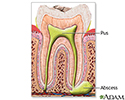Tooth abscess
Periapical abscess; Dental abscess; Tooth infection; Abscess - tooth; Dentoalveolar abscess; Odontogenic abscessA tooth abscess is a pocket of pus caused by a bacterial infection.
Causes
A tooth abscess may form if there is tooth decay. It may also occur when a tooth is broken, chipped, or injured in other ways. Openings in the tooth enamel allow bacteria to infect the center of the tooth (the pulp). Infection may spread from the root of the tooth to the bones supporting the tooth.
Tooth decay
Dental cavities are holes (or structural damage) in the teeth.

Infection results in a buildup of pus and tissue swelling within the tooth. This causes a "toothache". The toothache may stop if pressure is relieved. But the infection will remain active and continue to spread. This will cause more pain and can destroy tissue.
Symptoms
The main symptom is a severe toothache. The pain is continuous. It does not stop. It can be described as gnawing, sharp, shooting, or throbbing.
Other symptoms may include:
- Bitter taste in the mouth
-
Breath odor
Breath odor
Breath odor is the scent of the air you breathe out of your mouth. Unpleasant breath odor is commonly called bad breath.
 ImageRead Article Now Book Mark Article
ImageRead Article Now Book Mark Article - General discomfort, uneasiness, or ill-feeling
-
Fever
Fever
Fever is the temporary increase in the body's temperature in response to a disease or illness. A child has a fever when the temperature is at or abov...
 ImageRead Article Now Book Mark Article
ImageRead Article Now Book Mark Article - Pain when chewing
- Sensitivity of the teeth to hot or cold
- Swelling of the gum over the infected tooth, which may look like a pimple
-
Swollen glands of the neck
Swollen glands
Lymph nodes are present throughout your body. They are an important part of your immune system. Lymph nodes help your body recognize and fight germ...
 ImageRead Article Now Book Mark Article
ImageRead Article Now Book Mark Article - Swollen area of the upper or lower jaw, which is a very serious symptom
Exams and Tests
Your dentist will closely look at your teeth, mouth, and gums. It may hurt when the dentist taps the tooth. Biting or closing your mouth tightly also increases the pain. Your gums may be swollen and red and may drain thick material.
Dental x-rays and other tests can help your dentist determine which tooth or teeth are causing the problem.
Treatment
The goals of treatment are to cure the infection, save the tooth, and prevent complications.
Your dentist might prescribe antibiotics to fight the infection. Warm saltwater rinses may help ease the pain. Over-the-counter pain relievers may relieve your toothache and fever.
Do not place aspirin directly on your tooth or gums. This increases irritation of the tissues and can result in mouth ulcers.
Mouth ulcers
Mouth ulcers are sores or open lesions in the mouth.

A root canal may be recommended in an attempt to save the tooth.
If you have a severe infection, your tooth may need to be removed, or you may need surgery to drain the abscess. Some people may need to be admitted to the hospital.
Outlook (Prognosis)
Untreated abscesses may get worse and can lead to life-threatening complications.
Prompt treatment cures the infection in most cases. The tooth can often be saved.
Possible Complications
These complications can occur:
- Loss of the tooth
- Blood infection
- Spread of infection to soft tissue
- Spread of infection to the jaw bone
- Spread of infection to other areas of the body, which can cause brain abscess, inflammation in the heart, pneumonia, or other complications
Brain abscess
A brain abscess is a collection of pus, immune cells, and other material in the brain, caused by a bacterial or fungal infection.
 ImageRead Article Now Book Mark Article
ImageRead Article Now Book Mark ArticlePneumonia
Pneumonia is inflamed or swollen lung tissue due to infection with a germ. This article covers community-acquired pneumonia (CAP). This type of pneu...
 ImageRead Article Now Book Mark Article
ImageRead Article Now Book Mark Article
When to Contact a Medical Professional
Call your dentist if you have a throbbing toothache that does not go away, or if you notice a bubble (or pimple) on your gums.
Prevention
Prompt treatment of dental decay reduces the risk of developing a tooth abscess. Have your dentist examine any broken or chipped teeth right away.
References
Hewson I. Dental emergencies. In: Cameron P, Little M, Mitra B, Deasy C, eds. Textbook of Adult Emergency Medicine. 5th ed. Philadelphia, PA: Elsevier; 2020:chap 17.
Pedigo RA Oral medicine. In: Walls RM, ed. Rosen's Emergency Medicine: Concepts and Clinical Practice. 10th ed. Philadelphia, PA: Elsevier; 2023:chap 56.
-
Tooth anatomy - illustration
The structure of the tooth includes dentin, pulp and other tissues, blood vessels and nerves imbedded in the bony jaw. Above the gum line, the tooth is protected by the hard enamel covering.
Tooth anatomy
illustration
-
Tooth abscess - illustration
A collection of infected material (pus) resulting from bacterial infection of the center (pulp) of a tooth.
Tooth abscess
illustration
-
Tooth anatomy - illustration
The structure of the tooth includes dentin, pulp and other tissues, blood vessels and nerves imbedded in the bony jaw. Above the gum line, the tooth is protected by the hard enamel covering.
Tooth anatomy
illustration
-
Tooth abscess - illustration
A collection of infected material (pus) resulting from bacterial infection of the center (pulp) of a tooth.
Tooth abscess
illustration
Review Date: 3/31/2024
Reviewed By: Michael Kapner, DDS, General Dentistry, Norwalk Medical Center, Norwalk CT. Review provided by VeriMed Healthcare Network. Also reviewed by David Zieve, MD, MHA, Medical Director, Brenda Conaway, Editorial Director, and the A.D.A.M. Editorial team.




